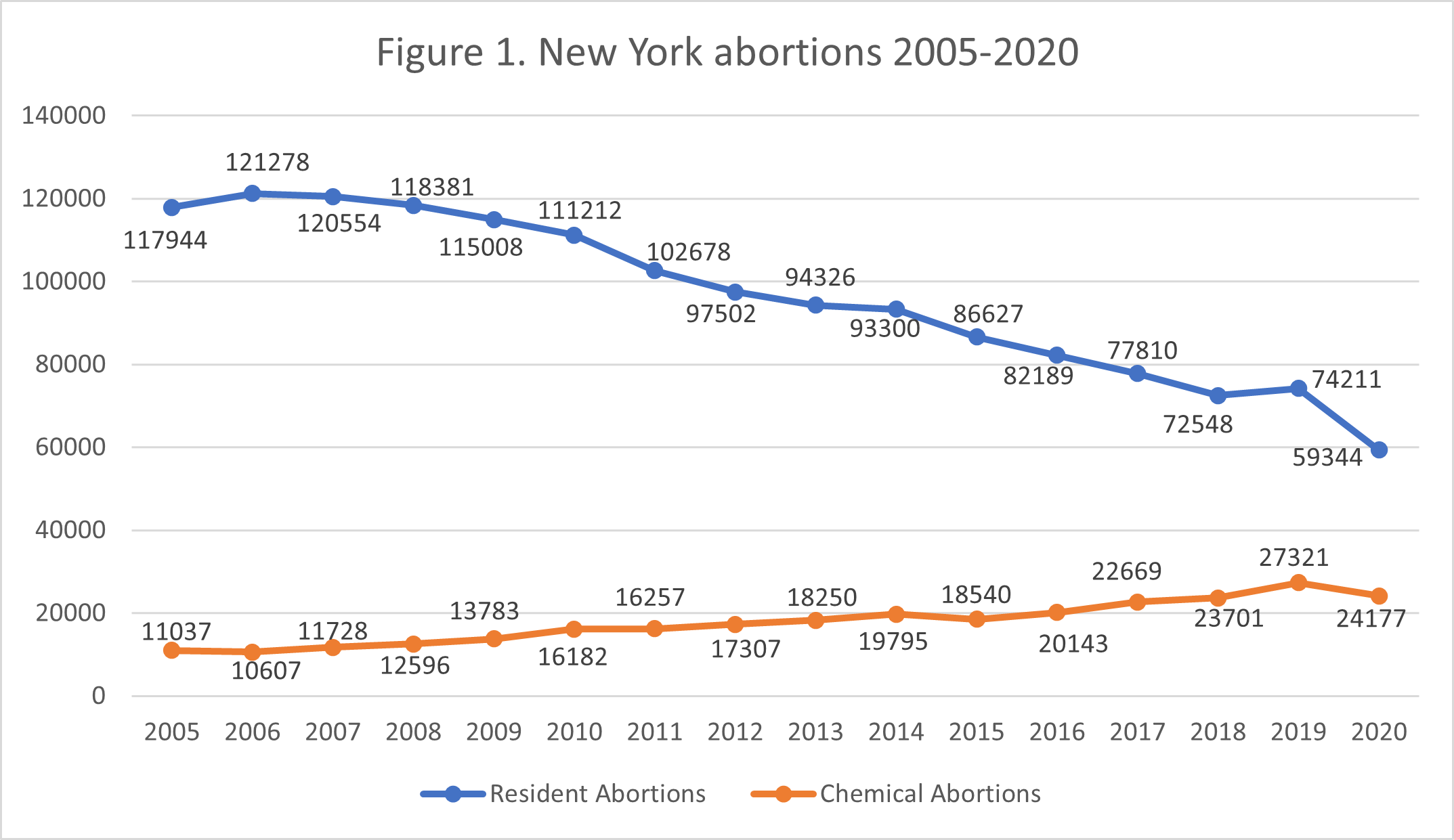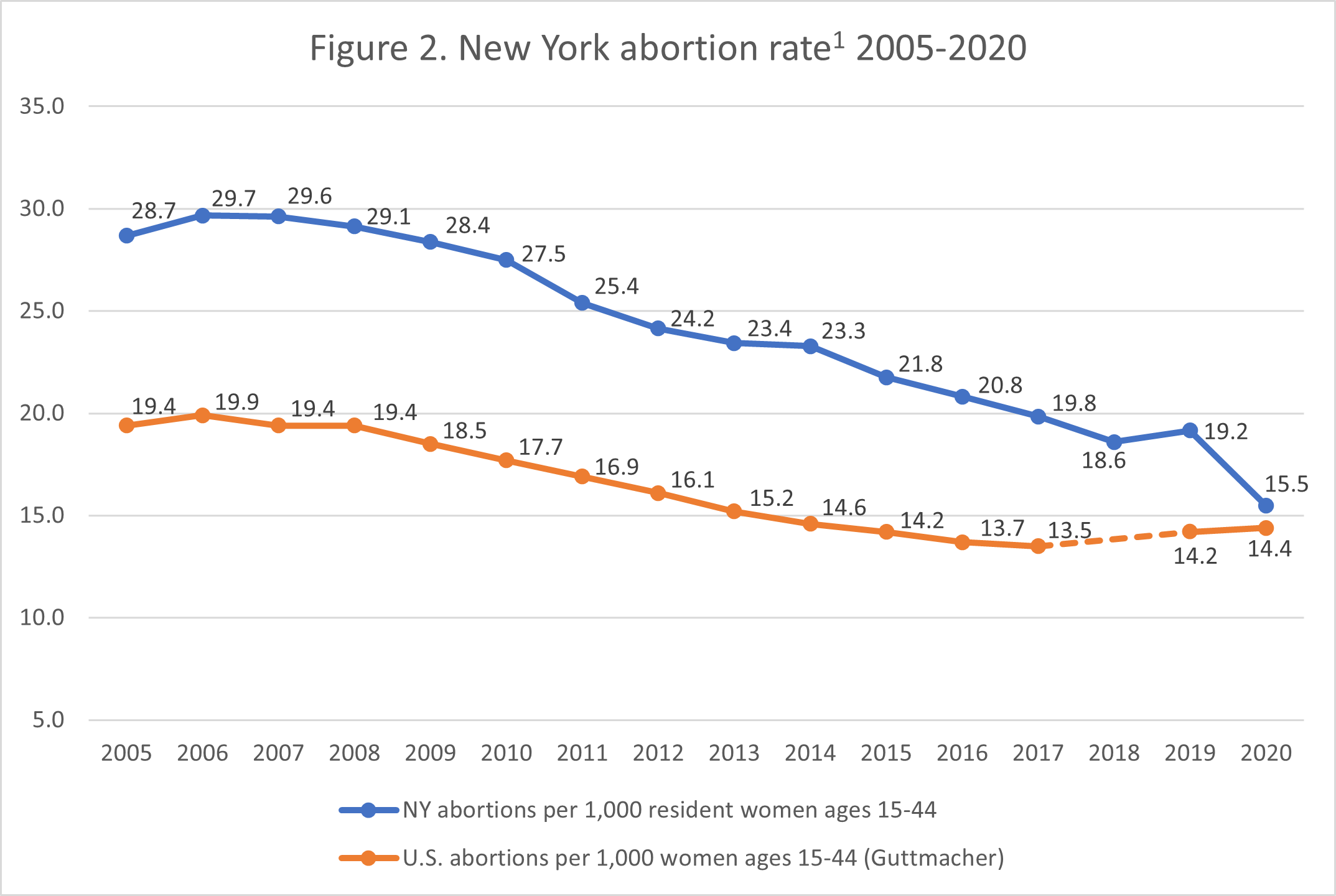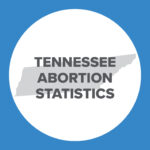Abortion Reporting: New York (2020)
New York’s 2020 abortion statistics were published online by the New York Department of Health in December 2022, showing that abortions performed on New York residents decreased from 2019.
Statistics and Changes in New York Abortions, 2019-2020

The change in abortions and the abortion rate reflects abortions performed on New York Residents only. The report does not include information on Planned Parenthood’s New York abortion market share.
Abortion Totals and Trends
In 2020, there were 59,344 abortions reported to have been performed in New York on state residents, down 20 percent from the previous year. Chemical abortions decreased by 12 percent; however, the number of chemical abortions performed on New York residents has more than doubled since 2005 (Fig. 1). Charlotte Lozier Institute (CLI) estimates that New York’s resident abortion rate was 15.5 abortions per 1,000 women of childbearing age, down 19.2 percent from the previous year, but still higher than Guttmacher’s estimated national abortion rate of 14.4 for 2020 (Fig. 2).
Separate from the state report, New York reported to the U.S. Centers for Disease Control and Prevention (CDC) that 63,142 total abortions, including 25,104 chemical abortions, occurred in 2020. Total abortions decreased by 20 percent, like what the state published in its own tables, and chemical abortions decreased by 12 percent from 2019. However, New York’s state abortion report does not include information on abortions obtained by nonresidents.
It is likely that many New York abortions are unreported. The Guttmacher Institute estimates that 110,360 abortions occurred in the state in 2020, over 47,000 abortions more than the total New York reported to CDC. Guttmacher also reported that New York abortions increased from 2017, while the state of New York reported that they declined.
State Report Summary
Of the 59,344 abortions performed on residents of New York, 61 percent were obtained by women from New York City, and 39 percent were performed on women from Upstate New York. Nine percent of the abortions performed on New York residents were on girls under the age of 20, including three percent on minor girls ages 17 and younger. Twenty-six percent were performed on women in their early twenties, and 29 percent were obtained by women in their later twenties. However, because there are more New York residents in their later twenties than in their early twenties, the abortion rate for women ages 20 to 24 (24.8 abortions per 1,000 women) was actually higher than the abortion rate of women ages 25 to 29 (23.7 abortions per 1,000 women). Twenty-one percent of the abortions were on women ages 30 to 34 and 12 percent were on women ages 35 to 39. Women ages 40 and older obtained four percent of the abortions. Maternal age was not reported for 75 abortions (0.1 percent).
Thirty-six percent of New York abortions were obtained by black women, and a quarter were performed on white women. However, 39 percent were performed on women of other or unknown races. New York separately reports that 78 percent of the abortions were performed on non-Hispanic women, compared to 22 percent on Hispanic women. Twenty-eight percent of the abortions were performed on women who reported no previous abortions. Twenty-one percent were performed on women with one prior abortion, and 30 percent were obtained by women with two or more previous abortions. The number of prior abortions, if any, was not reported for 21 percent.
Sixty-four percent of the abortions performed on New York residents occurred earlier than nine weeks of gestation. Twelve percent were reported between nine and 10 weeks of gestation, and six percent occurred between 11 and 12 weeks. Four percent of the abortions were performed from 13 to 15 weeks of gestation. Three percent occurred between 16 and 19 weeks. Two percent of New York resident abortions (1,280) were performed at 20 weeks of gestation or later. The number of late-term abortions was likely even higher, as gestational age was not reported for nine percent of the abortions.
Multiple abortion methods can be reported for each abortion, so the number of abortions reported for each type of abortion procedure sums to greater than the total number of New York resident abortions. Suction curettage was used for 49 percent of the abortions, while 41 percent were chemical. Seven percent of the abortions were performed using dilation and evacuation, and four percent were dilation and curettage procedures. Saline injections were used for 109 abortions (0.2 percent), and prostaglandins were used for 35 abortions (less than 0.1 percent). Another type of procedure was used for 151 abortions (0.3 percent).
Most New York resident abortions (92 percent) occurred in nonhospital facilities, while eight percent were performed in hospitals. Forty-nine percent of the abortions were funded by New York Medicaid funds. Due to the Hyde Amendment, federal Medicaid funds do not pay for abortions in the vast majority of cases, but some states, including New York, choose to use their own state Medicaid dollars to fund abortions for Medicaid enrollees. Twenty-eight percent of the abortions were covered by other insurance, and four percent were covered by HMO plans. Eleven percent of the abortions were self-pay. There were 492 abortions (0.8 percent) funded by multiple sources, while the source of payment was not reported for eight percent of the abortions.
COVID-19 and Abortion in New York
As coronavirus (COVID) ravaged the state of New York during the early months of the pandemic, former New York Governor Andrew Cuomo ordered all elective surgeries in New York to be cancelled. However, he did not consider abortions to be elective surgeries and, following the call of the National Abortion Federation, he allowed abortion provision in New York to continue. In fact, the New York Attorney General, Letitia James, pushed for increased abortion access during COVID in a letter to the U.S. Department of Health and Human Services and U.S. Food and Drug Administration. However, regardless of the state’s promotion of abortion provision during the pandemic, the New York Times reported that at least 10 percent of abortion centers closed in New York during 2020. These closures could explain the large decrease in abortion provision on New York residents in 2020.
Legislative Changes
In January 2019, former Governor Cuomo signed New York’s Reproductive Health Act into law. The law explicitly permits abortion up until 24 weeks of pregnancy and beyond, in effect allowing abortion up to birth through a broad “health” exception. This law codified Roe v. Wade into state law and expanded abortion by dangerously allowing for medical professionals who are not doctors to perform abortions in New York. The law also removed abortion from the state’s criminal code and shielded doctors who perform abortions from prosecution.
When the Dobbs decision was still undecided in early 2022, New York lawmakers introduced and were pushing a bill that would create a state fund to pay abortion providers and cover costs for low-income or un/underinsured abortion patients. In May 2022, New York Governor Kathy Hochul announced that the state was allocating $35 million to support abortion providers in the state and provide patients and providers with security. In early June 2022, a series of laws were passed, enacting legal shields for abortion providers and patients.
Following the overturn of Roe v. Wade on June 24, 2022, the New York legislature passed an Equal Rights Amendment which, if enacted, would enshrine the right to get an abortion and access contraception in the State Constitution. However, the change will not occur right away as amending the state constitution in New York takes years as two separately elected legislatures must pass the amendment and then voters must pass it by referendum. Furthermore, the governor’s office announced that following the Dobbs decision, it would be deploying a media and advertising education campaign, championing abortion rights and access in New York, at mass transit hubs, airports and over digital channels. Along similar lines, the state also created and published a new website dedicated to informing people on New York’s state laws regarding abortion and provider locations.
State Ranking
In 2016, CLI evaluated abortion reporting across the United States, and New York State’s reporting was ranked at 39th best. As CLI has previously recommended, New York could work to improve the accuracy and completeness of the abortion data it collects. The Guttmacher Institute’s estimate of the abortions performed in New York in 2020 is 75 percent higher than the total number of abortions that New York reported to the Centers for Disease Control and Prevention that year. Additionally, New York failed to meet standards for inclusion in several tables in the 2020 CDC report. New York could also collect and report data related to abortion complications.


- Rates were calculated by CLI using the following formula: (number of abortions performed in New York on resident women ÷ number of resident women ages 15-44) x 1,000. Rates may differ slightly from previous CLI articles due to revised population estimates. Population estimates were obtained from CDC WONDER. Estimates for 2005-2009 are intercensal estimates of the July 1 resident population. Estimates for 2010-2020 are Vintage 2020 postcensal estimates of the July 1 resident population. Estimates were produced by the U.S. Census Bureau and the National Center for Health Statistics.
Click here to view reporting from:20212019201820172016
Click here to view reporting from New York City:202120202019

























